Ayodhya: Latadevi, 82, stepped off the Ayodhya Express with a mission. Her aches and pains had disappeared as she travelled overnight from Delhi in the train’s general compartment, took a dip in the frigid waters of the Sarayu River, and walked through Ayodhya with her 55-year-old son Suraj Singh to the newly constructed Ram temple, dragging a blue stroller and two bags behind them. All this for a blink-and you-miss 30 second darshan—because “Lord Ram was pulling her towards him.”
She only got a moment’s glimpse to take in the newly consecrated black-coloured, larger-than-expected idol. And then she was pushed out of the fragrant sanctum sanctorum by the security guards back into the temple premises.
But that was enough for her. “I feel like I saw heaven for a moment,” Latadevi said, resting against a metal barricade draped in marigold, before sinking back into her age.
The last time she stood there was sixty years ago, with her newlywed husband by her side. And where now stands her Ram Mandir, there was the masjid. As she exited the temple complex, she tucked her blue shawl tightly around her and turned around to take one last look at the temple, draped in flowers.
What sets the Ram Mandir apart from other pilgrimage sites like Sabarimala and Tirupati is the civilisational milestone it has become in people’s mind. It’s an era-defining moment that never left the Indian political imagination. It existed in collective memory for decades as a dream to cling on to, a symbol of Hindu civilisational glory.
Now, Ayodhya and the Ram temple are part pilgrimage, part tourism, part endurance sport for Latadevi, her son and thousands like them. And it’s this hype that people are chasing, celebrating a shared sense of victory and vindication—and then posting it online. It’s what makes the Ram Mandir appeal to all generations: its political realisation is happening alongside the fact that religion is trendy again.
“Whatever happened to Babri, it’s good that it happened,” said Latadevi, her voice quivering. She had seen the birth and rise of independent India, and felt this was a moment in history she truly wanted to be a part of.
The mother and son had made a beeline for the temple directly from the train station, freshening up at Ayodhya’s Lata Mangeshkar Chowk and then dragging their luggage for kilometres, first for a darshan at the Hanuman temple at Hanuman Garhi, and then to the brand new Ram Mandir.
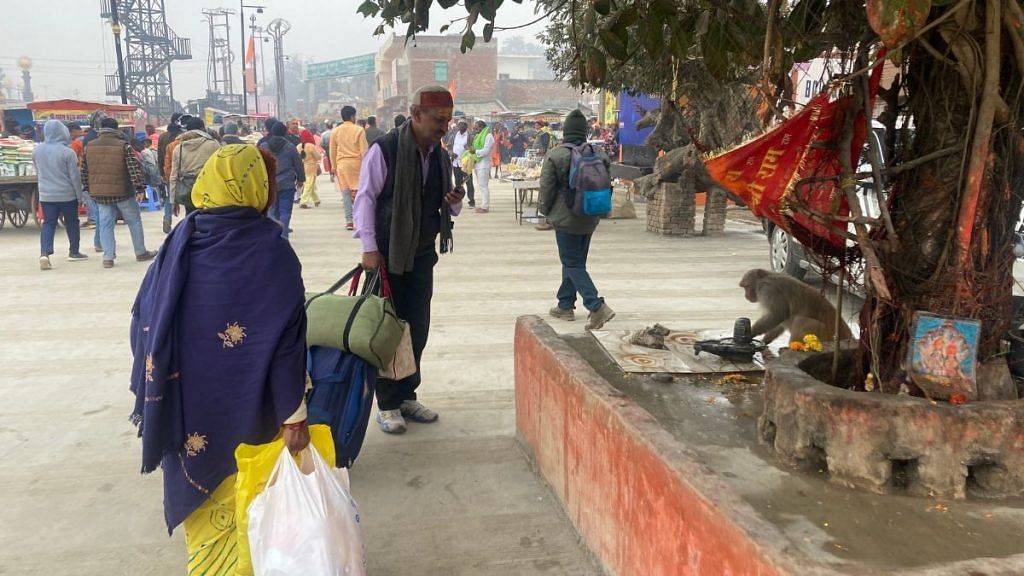
“I just prayed that our next steps will be better than our last, and that my family’s good fortune continues,” said Singh.
His relationship with the temple city has also changed. “We’re from here, so it was not that big of a thing to us,” said Singh. “I thought, now I have to come to only see the temple.” But when he returned, the significance of all that had happened, building to this moment, hit him. “Lord Ram is finally back in his castle after 500 years, and I feel like all my worries have been forgotten!”
One of the family’s major concerns is the marriage of Singh’s eldest daughter, confided Latadevi.
“The Ram Mandir signifies the start of a new age for India—and this darshan is an auspicious time for our family,” said Singh, his mother sitting beside him.
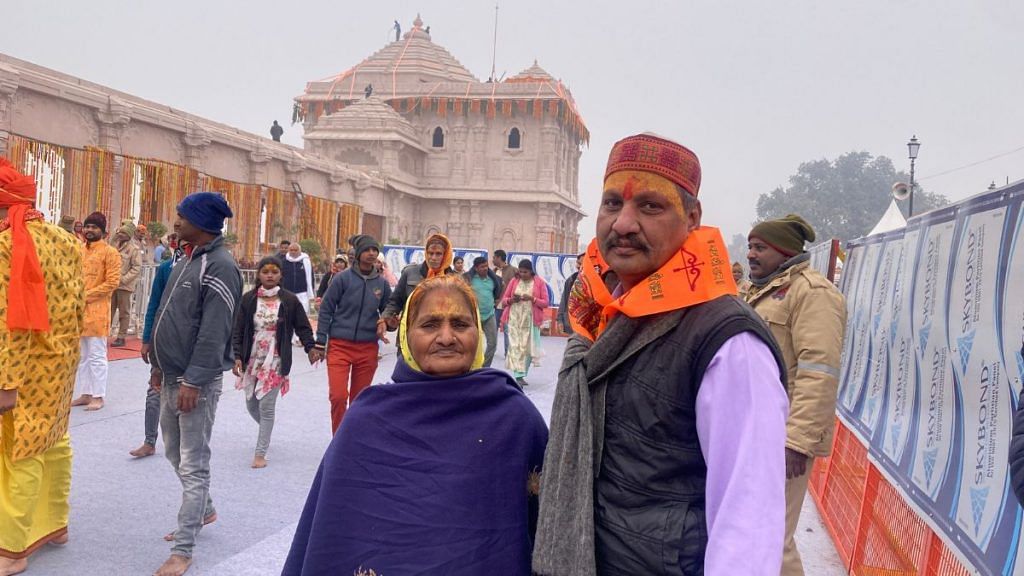
Also read: Ayodhya is holding its breath for greatness. ‘If you build it, they’ll come’
The ritual of worship
The Ayodhya Express from Delhi hurtled towards Ayodhya, collecting devotees along the way. At Hapur and Moradabad, huge groups clambered onto the coach, chanting ‘Jai Shri Ram’. One passenger, Rachit Awasthi, made sure to take a photo with his saffron Ram flag. Other passengers disembarked to film the revelry.
The question on everyone’s lips was “Are you going to Ayodhya? For darshan?”
Many were local residents returning home—one passenger, Ayodhya local Pramila Devi, immediately responded to this question posed by Awasthi, a Delhi businessman-turned-pilgrim.
“Of course! Why wouldn’t I be? Ram has come back home!” she said.
Smart phones, cameras and selfie sticks were as ubiquitous as saffron flags and tilaks, as visitors rushed to document their devotion. It began from the Ayodhya Express where all the devotees were carrying GoPros and cameras and taking photographs—setting them apart from the Sangh Parivar cadre.
“We’re the ‘Insta generation,’ so of course we’ll take photos and post them,” said Awasthi, who had taken the Ayodhya Express on a solo trip to see the temple. He had made sure to take photos of himself and the train holding a saffron flag of Ram. He couldn’t wait to visit the temple, and so decided to ditch his friends and family and ride the first wave of visits to the hallowed ground.
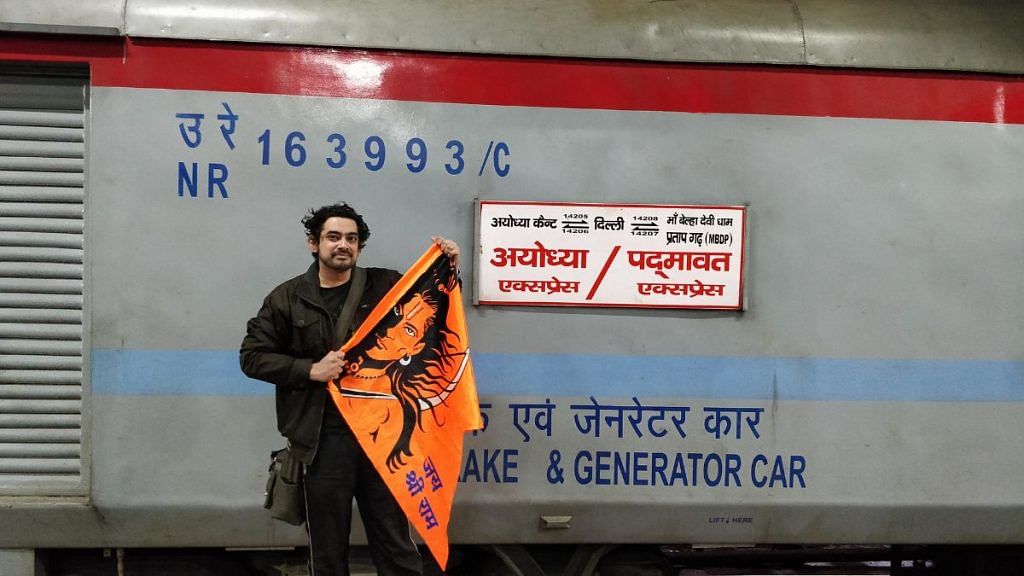
This seemed to be a trend aboard the Ayodhya Express: many small groups of men were travelling together and documenting their journey. A 35-year-old marketing professional from Delhi, Yogesh had bought a GoPro expressly for the trip. He was travelling with his two friends, and Ayodhya was their next adventure.
Another vlogger, Gautam, who runs a YouTube channel called Nomadic Safar, was also documenting his train ride on a GoPro, whispering his excitement to his followers. He got off the train and immediately began filming people chanting “Jai Shri Ram”—even the Ayodhya Cant station manager was cheering on the crowds.
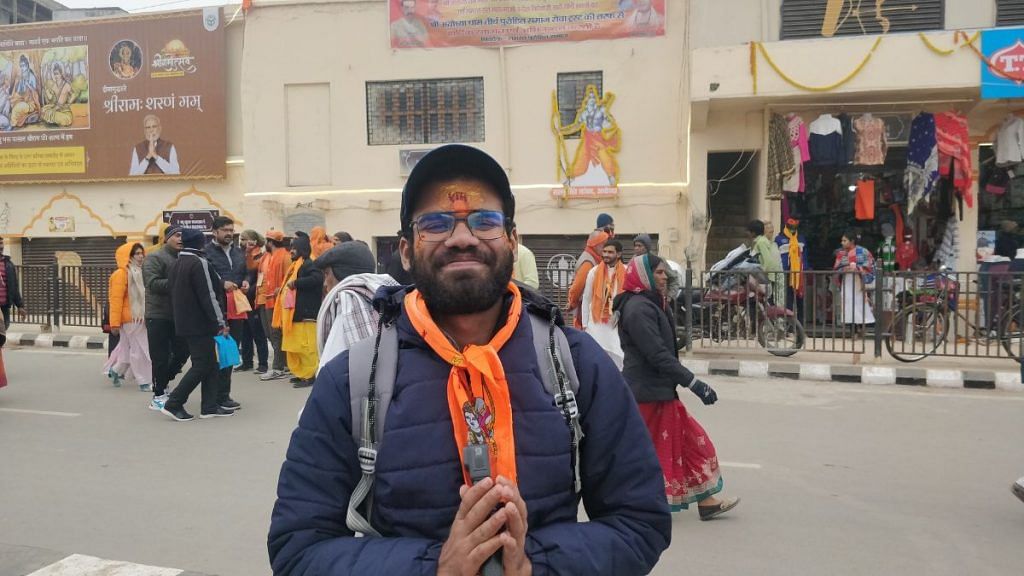
Anticipation coursed through Latadevi and Singh as they disembarked in Ayodhya, after the fog delayed their journey by an hour. They couldn’t wait to do their darshan, but the mother and son’s first stop had to be the Sarayu River.
In the freezing cold, the two quietly bathed in the river and freshened up. They changed into more formal clothes—a neat shirt and trousers for Singh, a yellow striped sari for Latadevi—and then walked to a priest. He adorned their foreheads with tilaks and “Shri Ram”.
The next stop was a small, dilapidated temple dedicated to Ram—about 2km away from their main destination. They dropped off their bags and prayed to the idol there. Latadevi used the restroom, while Singh quickly shaved himself to look his best and redid his tilak. She combed her hair in the mirror, which she didn’t have access to by the river.
The tiny temple’s mahant, Jagnayak Das, has been on the phone all morning answering questions on how to visit the main Ram Mandir. The previous day, 23 January, was the first day the temple was open to the public and there was a lathi charge to quell the crowds — security has been beefed up now, and phones and bags have to be deposited at the temple locker.
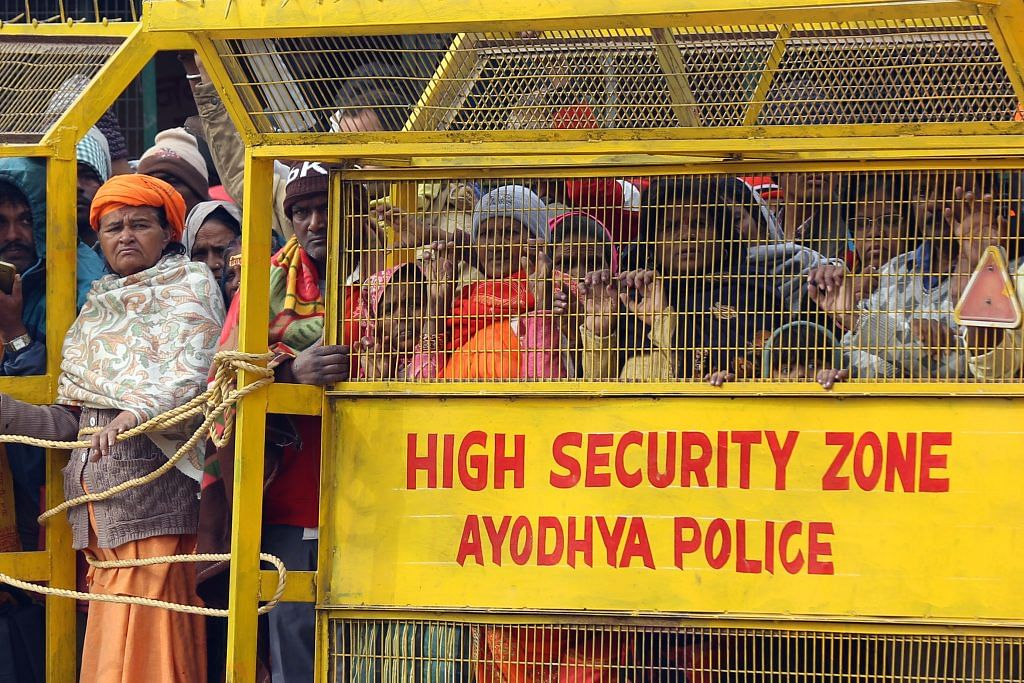
Das wears the air of a man in demand. He has been watching the politics of the Ram Mandir over the last few decades while running a Ram mandir himself. He’s been doing the grunt work of running a temple with barely any funds for the last 25 years, and now he’s fielding phone calls from the L&T engineers involved in building the Ram Mandir—he’s an Ayodhya local, and a point of contact for many pilgrims as well. Hindus are finally getting their respect in India, he says, and his dedication is finally getting the recognition it deserves.
Das looked doubtful at Latadevi, and told Singh it might be hard for her to brave the crowd and trek to the temple. “There’s too much public,” he says.
Singh is unconcerned. “She has himmat (courage),” he says with a grin.
And his mother does make it all the way through, slowly walking behind her son for hours.
“I’ve been thinking about returning home since April,” she confides. “Now look, it’s like Lord Ram has personally called us home!”
Singh booked tickets to Ayodhya in November, right after the date of the consecration was announced. His wife and three children—the two schoolteacher daughters and the son an MBA student—will most likely make the trip with him during the summer during the vacation. But it was important for him to visit the temple as soon as possible with his aging mother, before depositing her in relatives’ care in their ancestral village for the next few months.
On the long walk to the temple—teeming with devotees bursting into song and chants of ‘Jai Shri Ram’—Singh occasionally takes out his phone to video call his colleague at the Indira Gandhi International Airport, where he works as an accounts manager in the catering section. His colleague wanted to be a part of the darshan too.
They spoke on video call around three times during the trek towards the temple. A call was made during a chai break, while Latadevi sat on her haunches. His colleague’s excitement levels were infectious: he kept thanking Singh profusely for letting him be part of the pilgrimage.
It’s so crowded that extra central armed police forces have been brought in, but the energy is electric. Even the security forces can’t resist the pull––they have their phones out—documenting instead of doing their duty. Camouflage uniforms flashed in the sea of saffron as they tried to maintain order, phone in one hand and baton in the other.
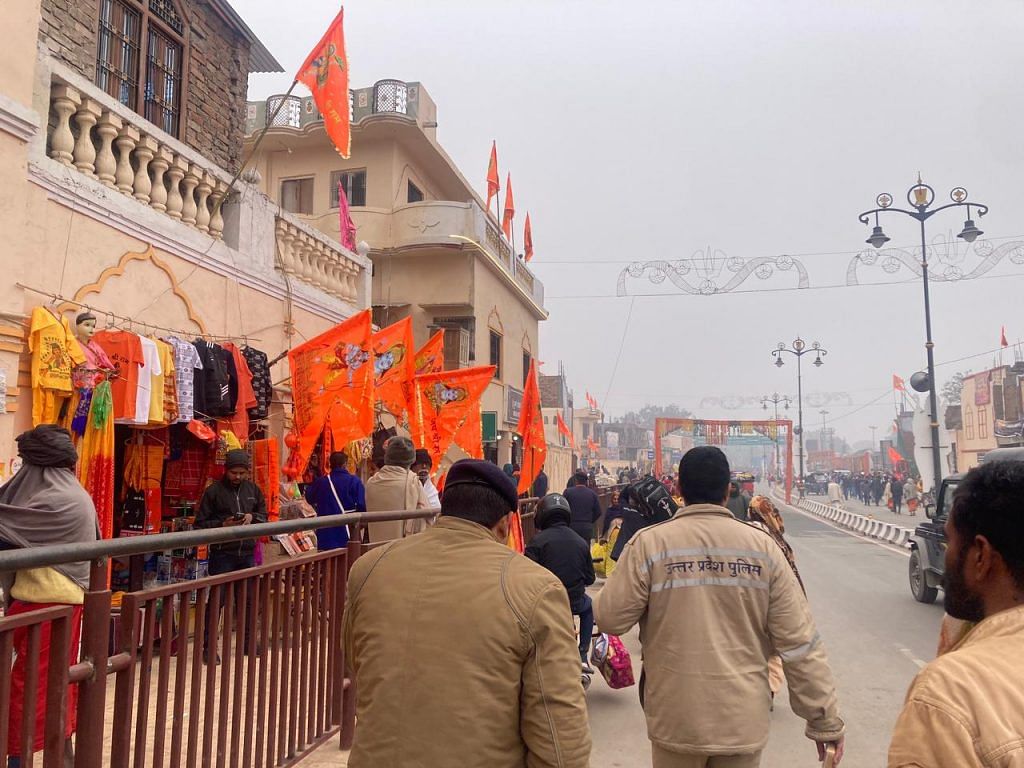
The same music about Ram’s return to Ayodhya (‘Ram Aayenge’) has followed the mother and son from off the Ayodhya Express to Ayodhya — the same chants singing Ram’s praises, the same bhajans extolling his morals, his eyes, his dark skin, his kindness, his love, his kingdom. But it’s only adding to the excitement of anticipation and the frenzied sense of climax.
Singh stops to buy a Rs 20 saffron scarf, which says “Jai Shri Ram” and Om. Around them, other groups of people chant “Jai Shri Ram,” all traipsing towards the same destination — a collective ebb of saffron, flowing towards the Mandir. Latadevi joins in the chants occasionally, her shaky old voice always trailing at the end.
Also read: After Ayodhya, Indian secularism must stay vigilant, not give in to religious obscurantism
Documenting darshan
The darshan was over before Singh and Latadevi knew it, and that is why the journey became more important to record and reel. The entry to the grand temple was overwhelming, but so were the crowds. At this point, the path through the temple is lined with security, keeping a single file of devotees moving.
At the temple, Singh was dismayed to learn he had to deposit his phone in a locker, because it meant he couldn’t take a selfie inside the temple. He is slightly mollified by the fact that he can always return.
“Now Ram Rajya has properly begun, this temple isn’t going anywhere,” he said. “There’s so much excitement because now the full country feels the power of Ram, that’s why they want to take photos and share it.”
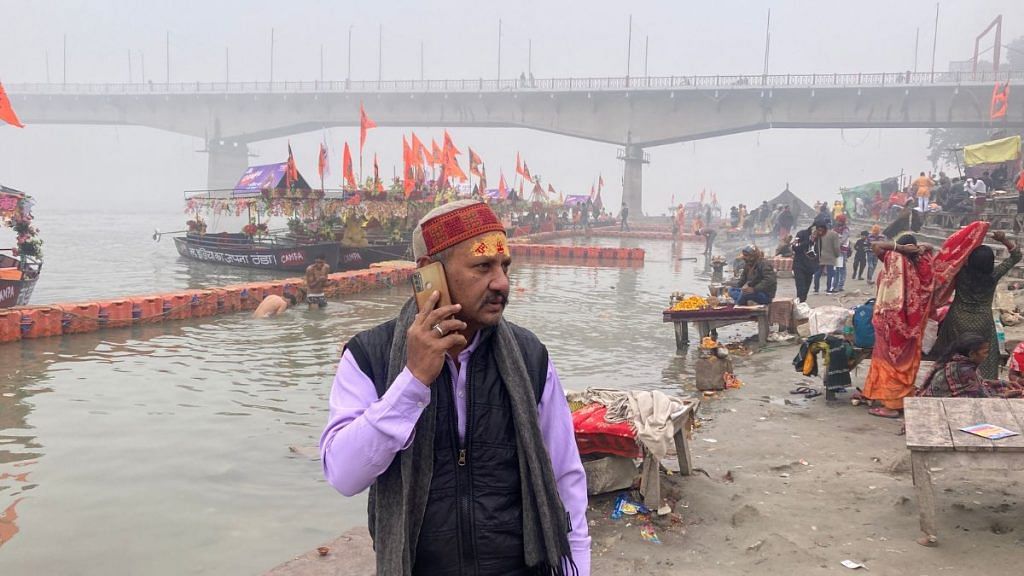
By that afternoon, he looked remarkably more orange, painted with tilaks and an assortment of saffron accessories. He was recording his own feelings after catching a glimpse of the idol. “All this is Lord Ram’s doing,” he said, gesturing around him.
Singh recognised Gautam from the railway station because of his camera. “See, everyone’s been hearing about Lord Ram since we were children,” said Singh, afterwards. “Every Hindu shares the same excitement, the same desire to see their childhood hero. And we all want to share this excitement with each other.”
He went on to talk about his love for Hanuman, and how much he admires Hanuman’s devotion to Ram—hence the first stop at Hanuman’s temple. To Singh, who says he’s been a Ram bhakt since he was conscious, Ram is the ultimate symbol of a dutiful man who provides for everyone. He conceded that Ram is not memorialised in mythology as a child as much as Krishna is, but what’s more important is that the Ramayana was a big part of Singh’s childhood.
He went on to quote the famous bhajan Bhaye Pragat Kripala, which describes how Ram appeared to his mother in his true form of Vishnu, and then she requested he assume the form of a child instead.
“The lord who bestows his mercy and compassion on those who suffer appeared before Kaushalya,” recited Singh, “And his mother Kaushalya was so happy to see him, he with the heart of sages in his great true form.”
Also read: Modi has defined new ‘political time’ at Ayodhya. It’ll reshape our future public culture
The politics of the Mandir
The memory of Ram Mandir politics, however, has taken a back seat.
The temple is the BJP’s biggest ideological project, and many devotees in Ayodhya say that it is what gave the BJP its popular mandate. And with its construction, the mandate has come full circle now.
“It was fantastic!” texted Awasthi about the darshan on the evening of 24 January, shortly before returning to see the temple at night. He went thrice that day, right after hopping off the train and checking into a hotel in Faizabad.
Both Singh and Awasthi are sure that a new mosque will be built, but neither believe Ayodhya will be peaceful after that. When told of several incidents of Hindutva mob violence across India after the consecration of the temple, Singh and Awasthi attributed it to extremist elements and condemned it.
The temple is climactic to any of these devotees; it is a starting point—for both Hindus and the BJP.
“After all, everybody’s religious here,” said Awasthi, gesturing at the sea of saffron around him. “Everyone will have the same story in Ayodhya. Now the Mandir has been made, it feels like Hindustan belongs to Hindus again.”
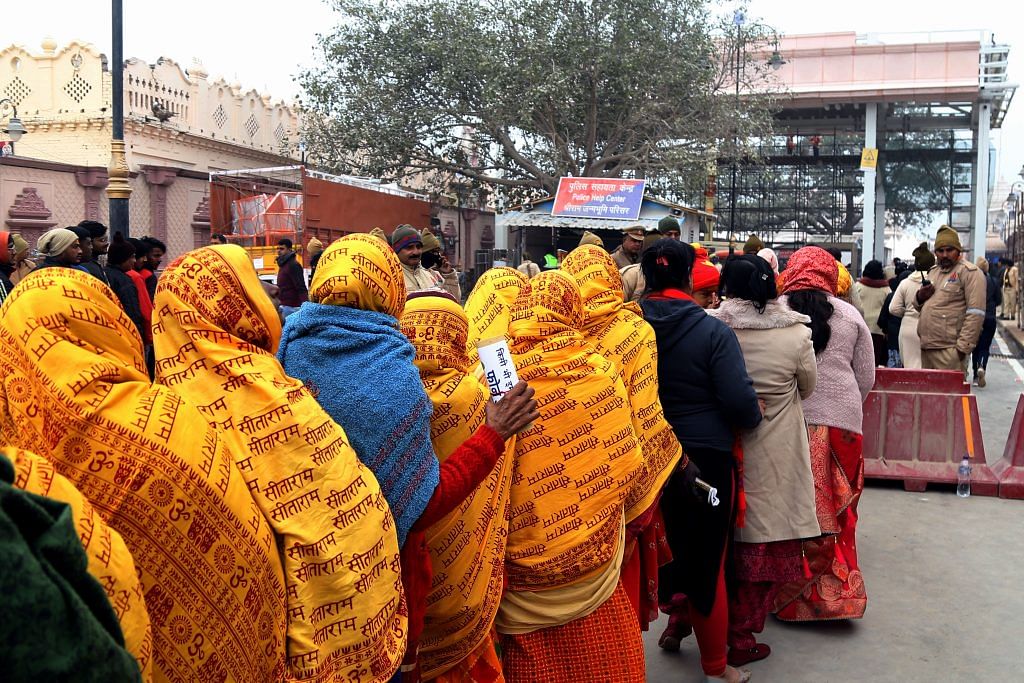
The conversation around the Mandir’s politics always comes back to Partition, that it was done on a religious basis — Pakistan for Muslims, Hindustan for Hindus. The Gandhian and Nehruvian dream of building a secular nation state is forgotten. Awasthi has Muslim ‘friends’, but it doesn’t change his idea of a Hindu India.
“The Babri Masjid was beautiful but I feel so good after visiting this temple, I have no more wishes now,” says Latadevi, walking out of the temple. She points at little piles of stone in the sand, and explains that those without homes have placed them there in the hope that Ram will make their dreams come true and ease their burdens.
“Just see. Within a year, they will have houses. That is the power of Ram, and that is the wonder of Ram Rajya,” she said.
(Edited by Prashant)


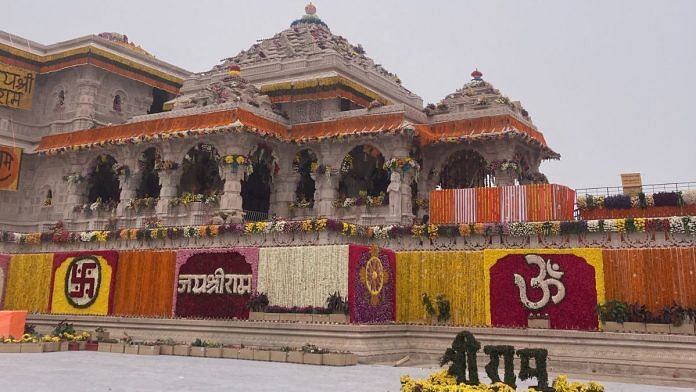

So where do Sikhs, Buddhists, Jains, Parsis go?